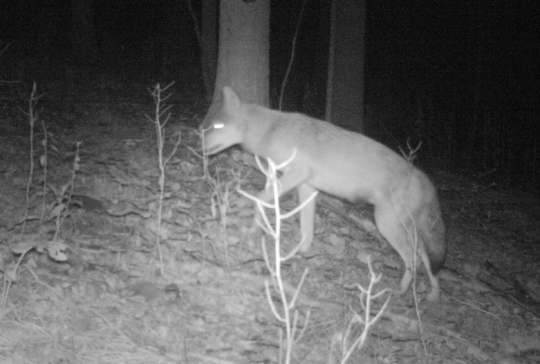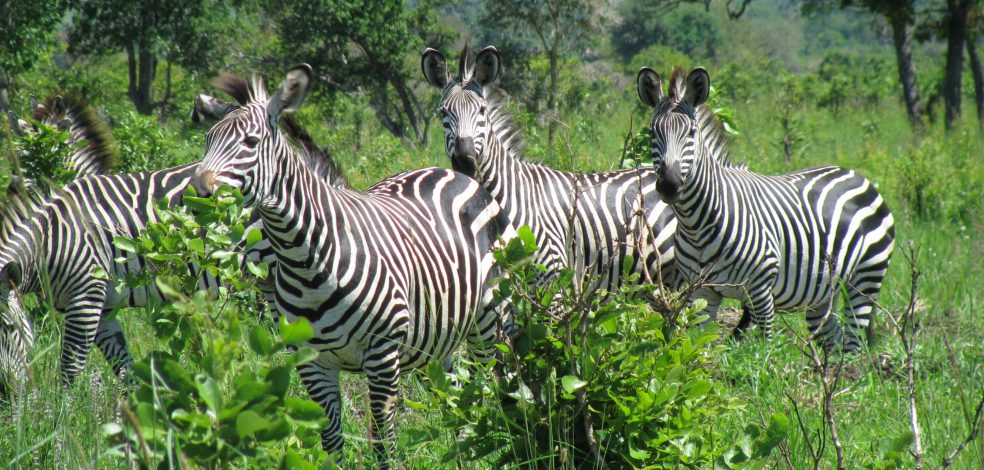Many people I know have had the unfortunate experience of a warm season bout with the following symptoms: fatigue, achy joints, headaches, dizziness, fever and night sweats. Some of these symptoms are part of the daily experience of someone who has reached my level of maturity (okay – age), but in combination they suggest infection by the bacterium Borrelia burgdorferi that is transmitted by Ixodes ticks, and causes Lyme disease. So three years ago, when I experienced those symptoms, I went off to my doctor (after some prodding by my wife) who immediately prescribed a regime of antibiotics that is effective against Lyme. My region of the United States (southern Appalachians) is a center of Lyme infection, so the diagnosis was pretty easy, and thankfully, the antibiotics were effective.

Each dot represents one verified case of Lyme disease in the United States in 2016. I live in the dark blotch in western Virginia.
Richard Ostfeld began investigating the ecology of Lyme disease as a result of a chance event. About 26 years ago Ostfeld started a new project that explored how white-footed mice may control populations of the invasive forest pest, the gypsy moth. Mice eat the moth pupae for a couple of weeks in mid-summer. When he started trapping at the Cary Institute of Ecosystem Studies in New York, he was amazed to see tremendous burdens of larval blacklegged ticks attached to the white-footed mouse (Peromyscus leucopus). At the field site there was a boom one year and a crash the following year in acorn abundance, which was followed, with a one year time lag, by a boom and a crash in mouse abundance. Ostfeld wondered what role fluctuating mouse abundance might play in human risk of exposure to tick-borne disease, and how factors affecting mouse abundance might influence the system.

This unfortunate mouse harbors 52 larval ticks. Credit: Ostfeld lab at Cary Institute.
Ixodes ticks have a two-year lifecycle, with eggs laid in the spring, six-legged larvae hatching out in summer, getting one blood meal from a rodent or bird host, and emerging as eight-legged nymphs the following spring. Nymphs find themselves a second host in spring or summer, from which they suck more blood and ultimately metamorphose into adults during the fall season. Adults seek large mammalian hosts, such as white-tailed deer; females feed on the deer, mate with males (who generally don’t feed), lay eggs and die, usually the following spring.

Human finger with (left to right) adult female, adult male, nymph and larval ticks. Credit: Ostfeld lab at Cary Institute.
What makes these ticks tick? Ostfeld, Taal Levi and their colleagues knew from previous work that biotic factors such as mice, acorns and deer were likely to be important, but that predators on mice might also play a role. It also seemed likely that abiotic factors such as temperature, moisture and snow cover could also be important. For 19 years, the researchers systematically collected data related to these factors from six large (2.25 ha) field plots at the Cary Institute. They used standard capture-mark-recapture methods to estimate rodent abundance, and data from the Cary Institute’s bow-hunting program to estimate deer abundance. They monitored the presence of carnivores with LED camera traps that were baited with cans of cat food.

Coyote captured on LED camera. Credit: Ostfeld lab at Cary Institute.
Lastly, the researchers needed to estimate tick abundance and the percentage of ticks that were infected with the Lyme disease bacterium, Borrelia burgdorferi. To estimate tick abundance, the researchers systematically dragged 1-m2 white corduroy drag cloths across each plot every three weeks throughout the times of peak tick abundance. Ticks that are searching for a host (known as questing ticks) will grab onto the drag cloth, so in essence, drag cloth censuses provides an estimate of ticks that have not had a blood meal. Tick infection rates were estimated by subjecting an average of 378 ticks per year to molecular analyses (initially direct immunofluorescence assay, and later quantitative PCR).

Researchers sample for questing ticks by dragging a cloth across the forest floor. Credit: Ostfeld lab at Cary Institute.
Across the 19 years of the study, the density of infected nymphs was strongly correlated to mouse density the previous year, and weakly correlated with deer density two years previously. Recall the details of the two-year life cycle; it takes a year to go from tick larva to nymph, and a second year to go from nymph to adult to eggs, so these time lags are not surprising. What is surprising is that the density of infected nymphs is negatively correlated with mouse density in the current year and with winter warmth.

Density of infected ticks (x 100) per 100 m2 in relation to (far left) mouse density (per 2.25 ha) in the previous year, (2nd from left) mouse density in the current year, (2nd from right) winter warmth, and (far right) deer density two years previous. Different color dots represent the six different field sites.
Ostfeld and his colleagues explain that during years of high mouse abundance, many nymphs were attached to rodent hosts, or had already had a blood meal, and thus were not collected on drag cloths. By using the abundant rodents as their secondary hosts, rather than people, high rodent abundance is actually decreasing the probability that the nymphs will infect a human. Infection of humans by adult ticks is less common than infection of humans by nymphs, because many nymphs don’t survive to adulthood, male adults do not feed, and adults are more likely than nymphs to be spotted and removed, due to their larger size.
Nymphal infection prevalence (NIP) measures the fraction or proportion of the nymphs within the community that are actually carrying the bacterium. From a human perspective, a high NIP indicates that a tick bite is relatively likely to lead to Lyme disease. There was only a small relationship between rodent density the previous year and NIP, so the researchers decided to see if the composition of the predator community might influence NIP. They reasoned that foxes and bobcats were known to be major mouse predators, so by eating mice, they would be removing infected ticks from the population. Raccoons and opossums have a double effect; they eat mice – though not as many as do foxes and bobcats. In addition they are dilution hosts, in that they provide blood for nymphs, but do not serve as a vector to the bacterium. Thus a community with all four of these predators was expected to reduce NIP. The effect of coyotes were more complex because they eat mice, which should reduce NIP, but they also eat or scare away other predators, such as foxes and opossums, which could increase NIP.

Effect size of predator community structure on nymphal infection prevalence (NIP). Top row animals are (left to right) fox, raccoon, opossum and bobcat. Communities with coyotes (bottom five communities) tend to have higher NIP, particularly if they lack other predators.
In general, more diverse predator communities tended to have lower nymphal infection prevalence. Communities with coyotes that also lacked some of the other predators tended to have the highest NIP values.
Ostfeld and his colleagues were surprised to discover that a warm and dry winter and spring season tended to depress tick abundance, while cold winters had little effect. Presumably, emerging nymphs can dry out under warm, dry conditions. The researchers were also surprised to observe the strong decrease in tick abundance associated with high mouse abundance in the current year. It is not uncommon for a boom in mouse abundance one year to be followed by a mouse population crash the next year. When that occurs, there will be a large number of questing nymphs lurking in the vegetation for hosts, and thus the potential for a major outbreak of Lyme disease.
note: the paper that describes this research is from the journal Ecology. The reference is Ostfeld, R. S., Levi, T. , Keesing, F. , Oggenfuss, K. and Canham, C. D. (2018), Tick‐borne disease risk in a forest food web. Ecology, 99: 1562-1573. doi:10.1002/ecy.2386. Thanks to the Ecological Society of America for allowing me to use figures from the paper. Copyright © 2018 by the Ecological Society of America. All rights reserved.

The worry of Lyme disease is the one thing that hampers my hiking anticipation. I hope by covering myself in DEET, the ticks will find me undesirable. So far, so good. Nice article!
LikeLike
Wow. Complicated. And another counterintuitive process. Had to draw a flow chart to try to keep track. Very educational. ck
________________________________________
LikeLike